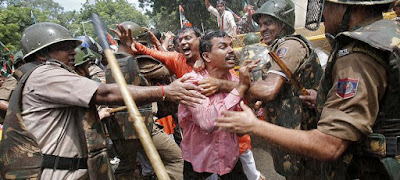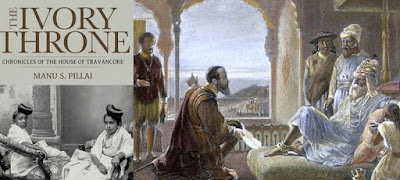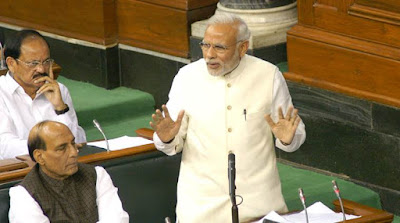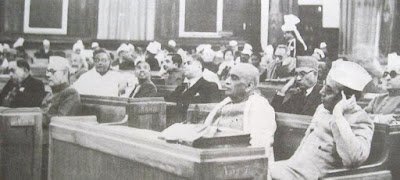By J. Zach Hollo
As India thrives and convulses in its
embrace of capitalism, one labor organizer sees himself as the last line of
defense for the working class and those being left behind as the country
develops.
Venkateswarlu
Manam (right) and his wife Lakshmi Marella (left).Copyright J. Zach Hollo
On a hot, humid afternoon in Visakhapatnam, a large city on
India’s southeastern coast, Venkateswarlu Manam had a visitor. It was a young
man named Raju, who had come to thank Manam for rescuing him from an abusive
episode with his employer.
It had begun when
Raju sold company property and didn’t hand over the revenue, like he was supposed
to. Raju had admitted his wrongdoing and apologized to his boss, saying he’d
pay the company back. But his boss, the manager of a gas cylinder distributor,
beat Raju, and chained him to the wall outside the office building.
It was then that
Raju’s aunt called Manam, who works for the Indian Federation of Trade Unions
(IFTU), telling him about the episode and pleading for help. Manam called to
the manager, who reluctantly agreed to release Raju and give him back his job.
Raju later told
Manam that his thievery was an act of desperation to pay interest fees to
private moneylenders. “You fool,” Manam replied. “Why didn’t you come to me
earlier?”
Settling
disagreements like these is part of Manam’s job. Most of his time consists of
sifting through legal paperwork for ongoing labor disputes, but random crises
like this one often arise.
As India thrives and
convulses in its embrace of capitalism, Manam sees himself as the last line of
defense for the working class, a guardian of the poor and those being left behind
as the country develops. India has experienced a sporadic flurry of growth
since its 1991 economic reforms, when the government deregulated the economy,
privatized many sectors, and opened up the country to greater foreign
investment. Over the past 24 years, development indicators such as educational
enrollment, child mortality, life expectancy, and percentage of people living
below the poverty line have consistently improved. But these accomplishments
belie India’s somber realities: the new economy has disproportionately
benefitted those who are already privileged. Even with great economic growth,
an estimated 363 million in India still live in poverty,
according
to a 2014 report by the Indian Planning Commission.
At the IFTU branch in the
state of Andhra Pradesh, Manam serves as the union’s vice president and also
advises the Visakhapatnam Slum Dwellers Welfare Association (SDWA). The SDWA
provides economic aid and legal services to residents in the city’s poorest
quarters, and is led by Manam’s wife, Lakshmi Marella, who shares her husband’s
activist bent.
Manam, who is 49, stands hunched
over, his left arm twisted and dangling at his side. He walks with a limp, and
though he often struggles to move from one place to another, he can get by,
even if it takes a bit longer. What Manam lacks in mobility he compensates for
in energy. He jumps from one bundle of paperwork to another, his voice serious
but chatty as he discusses cases with his colleagues in his home office. He
smiles easily under a whirl of hair oranged by the sun.
Manam’s battle for the poor,
and against the establishment he sees as their oppressors, began in college.
Raised by farmers in a village in Andhra Pradesh, he moved to Visakhapatnam to
study law at Andhra University. There, he joined a student group that visited
the city’s slums and organized political rallies against income inequality and
caste discrimination.
In the early 1990s, while he
was nearing the end of his law program, life on Manam’s family farm changed
dramatically. As India’s economy teetered on the brink of collapse in the late
1980s, the government acquiesced to a host of structural reforms imposed by
the World Bank in exchange for investment loans. Among those reforms was an agricultural policy
that deregulated the Indian seed market and brought it under the jurisdiction
of the World Trade Organization’s Agreement on Trade-Related Aspects of Intellectual
Property Rights (TRIPS). Seeds that Indian farmers had used their whole lives
became the intellectual property of American corporations like Monsanto and
Cargill, who collected royalties on their acquisitions and forced seed prices
to skyrocket.
Manam’s family had to stop
growing their own seeds, which they had normally replanted every year, and were
forced to buy more expensive seeds, ones that had been genetically modified so
that they could not be replanted in future seasons. The family also had to
switch from homemade fertilizer to a more expensive foreign brand. Nationwide,
imported food products made cheap by heavy subsidies from western countries
flooded the market, driving the price down on the crops that Manam’s family
sold.
“My input costs shot up from
4,000 to 15,000 rupees [$62 to $235],” remembers Manam’s brother Veeranjaneyu,
who still works as a farmer. “The yield increased a little, but not nearly
enough to cover the increase in input costs. And my crops sold for less money
than before. I was forced to take out six lakhs [$9,412] in loans from private
moneylenders. The loan has been a horrible burden on my life.”
Photo
by Vinay DV/Flickr, CC BY-NC
For India’s farmers, the debt
acquired in an effort to cope with the new trade rules has led to an epidemic
of suicides in the countryside, which continues to this day. According
to the Ministry of Agriculture, in the past three years more than 3,000
Indian farmers have committed suicide.
Having watched American
multinational corporations extract vast amounts of wealth from the Indian
countryside, and having seen firsthand the squalor of the urban slums, Manam
decided to dedicate his life to activism. “I knew then I wanted to work for the
people,” he says.
In college, Manam met Lakshmi,
a likeminded liberal student activist. They fell in love, married, and had two
daughters. Together, they help those most vulnerable in their community, one
desperate case at a time.
“Seeing the condition of
people around us, and knowing the reasons behind why they are suffering, how
could we sit back and allow it to continue?” Lakshmi says.
“The system now pits human
against human,” says Manam, arguing that capitalism reduces the world to
competition and cruelty. “People should always be kind and loving to others.
People should help one another, whether that person is family, a neighbor,
friend, or complete stranger.”
“I do not like the Chicago
School,” he volunteered to me recently, referring to the University of
Chicago’s famously conservative economics department — the onetime intellectual
home of Milton Friedman and birthplace for many of the economic theories that
justify the World Bank’s and World Trade Organization’s structural reforms.
“Globalization is just another word for Western hegemony,” Manam sighs.
Two photos of Bhagat Singh, a
socialist revolutionary who violently opposed British rule in the early
twentieth century, adorn a long pink wall in Manam’s office. Known as the
antithesis of Mohandas Gandhi, the peaceful champion of nonviolent resistance,
Singh rose to fame by taking part in the revenge murder of a British police
officer in 1928. In prison, he fasted for 116 days, dying at the gallows at age
23. Whereas Gandhi disavowed class struggle in favor of unified resistance to
the British, Singh remained devoted to Marxism, studying Lenin until the last
days of his life.
“I do not like Gandhi,” Manam
says. “I don’t believe India ever became independent. It went from being
colonized by the British to being colonized by multinational corporations.”
Manam sees his efforts with
workers and slum dwellers as part of a larger effort to manifest radical change
in the country. “We need a revolution,” he says. “We need to take up arms
against the government if we have to. There is so much suffering and so little
relief. Communism is the only way forward. Everyone should be equal. The
government should provide for the people. It should make sure people have
shelter and food when they are in need. It should give them education.”
A
communist banner is carried during a pro-farmers march through
Thiruvananthapuram, India, in 2011.
Photo by Johan Bichel Lindegaard/Flickr, CC
BY.
“Every Monday is grievance
day,” says Yuvaraj Narasimhan, the Visakhapatnam collector, a position much
like a mayor. “Everyone is free to come and speak to me and my colleagues. And
we often address the problems people tell us.”
Manam brushes it aside. “It is
a sham!” he shouts when I bring up the “grievance day” sessions. “The
government is deceiving the people into making them believe someone is
listening.”
“I wanted to be an official
once,” he continues. “Before I came to Visakhapatnam for university, I dreamed
of getting a law degree and joining the government. I wanted to be a minister.
I wanted to help the rural areas. I thought it was possible to serve in
politics without corruption, without partiality, in a way that would really help
the people. But after I moved here, I learned that idea was trash. It’s not
possible to do good within the system.”
On May 30, 2015, three days
after Manam had helped Raju, there was an incident involving a worker who
transported gas cylinders, which are commonly used in India to provide fuel for
cooking. This time, a 32-year-old transporter named Nagababu died on duty,
leaving behind a wife and two children.
“Nagababu would only come home
on Sundays. Otherwise, he was always working,” says Dhanalakshmi Lalam,
Nagababu’s wife. “He would drive all day. At night, he slept in the car to
guard the cylinders.”
Manam’s main task was to file
a formal complaint to the police detailing the man’s death. Otherwise, he says,
the company would have legal wiggle room to claim that the driver had not been
on duty, leaving them largely off the hook in compensating his family. “The
company has been abusing these workers,” Manam fumes. “They are only supposed
to work one eight-hour shift per day. But the company often has them work three
shifts straight.”
Before studying the autopsy or
drafting the paperwork, Manam had a more personal role to play. He was going to
the man’s home to pay his respects to the family, who live in a village two
hours west of Visakhapatnam. Manam left his house with two union colleagues at
5 p.m. They’d be there by sundown.
Photo
of Manam courtesy of J. Zach Hollo, who maintains the copyright.
Their small white van shot out
of the city and onto a long highway that weaved through thick patches of palm
trees, and past thatched-house villages next to sparkling Hyundai dealerships.
Even more than the city, the countryside was full of surreal juxtapositions.
The thatched-hut communities embodied serenity, but the road itself was a
violent organism, with trucks, cars, and motorcycles swerving and honking at
one another, surging onward with a ruthless sense of purpose.
Around 7 p.m., Manam and his
colleagues turned onto a smaller, more unkempt road, and soon arrived at the
village. About a hundred men had gathered in a field where Nagababu’s body lay
atop a tall stack of wood, his face covered in orange dust with a thick red bindi
mark on the forehead. Night was falling fast. A man lit the pyre.
The group gathered around
Manam, shaking his hand warmly and smiling at him with tired eyes. Many men in
this village work for the same company as Nagababu, and they all count on
Manam’s services. Manam spoke to them, asking about their working conditions
and telling them about the case he was filing to get Nagababu’s family more
compensation.
Afterward, the van drove to
the family’s house, a one-story brick home with a large porch draped by a
billowing embroidered sheet. Two candles cast a dim yellow glow over the
darkness.
Dhanalakshmi, Nagababu’s young
widow, sat on a cot with their two children, a five-year-old daughter and
three-year-old son, each of whom looked malnourished. When Manam entered,
clinging to a colleague’s arm as he walked, Dhanalakshmi began to weep.
Nagababu’s mother, short and skinny with long grey hair, was also there. Her
eyes were sunk so deep into her face that they were barely visible. She wept,
too.
Manam sat on a chair in front
of the family. He stayed quiet for several minutes and absorbed the sounds of
their grief. His eyes burned holes in the floor. Then he looked up and spoke.
He told them he was sorry for
their loss — he couldn’t imagine the pain they must be feeling to lose a
husband and son so young. He told them he was filing a police report on
Nagababu’s behalf, so the family might get more compensation from the company.
He told them he would need help from the family in days to come.
“Don’t be afraid. I know it is
hard now, but you must be determined,” he said to them. “You must have courage.
Don’t lose your courage.”
Dhanalakshmi paused her sobs
and nodded. She thanked him, saying the family would do everything necessary to
help the case.
After siting a few more
minutes, Manam stood up, took his colleague’s arm, and limped away. As the van
pulled out of the village and back onto the highway, one of them turned on the
stereo and flipped to a muffled song, a fast number sung by a chorus with
strong drums.
“This song was written during
the Cold War,” Manam tells me. His eyes stare searchingly out the window; wind
sails through his hair as he begins drumming his right hand on his leg.
“It’s about the hegemony of
the Soviet Union and the United States — and struggle to escape imperialism,”
he says. “They are singing, ‘How are we supposed to view the world? How can we
escape this misery?’”
* * *
The reporting of this story
was supported by the Pulitzer Center.















